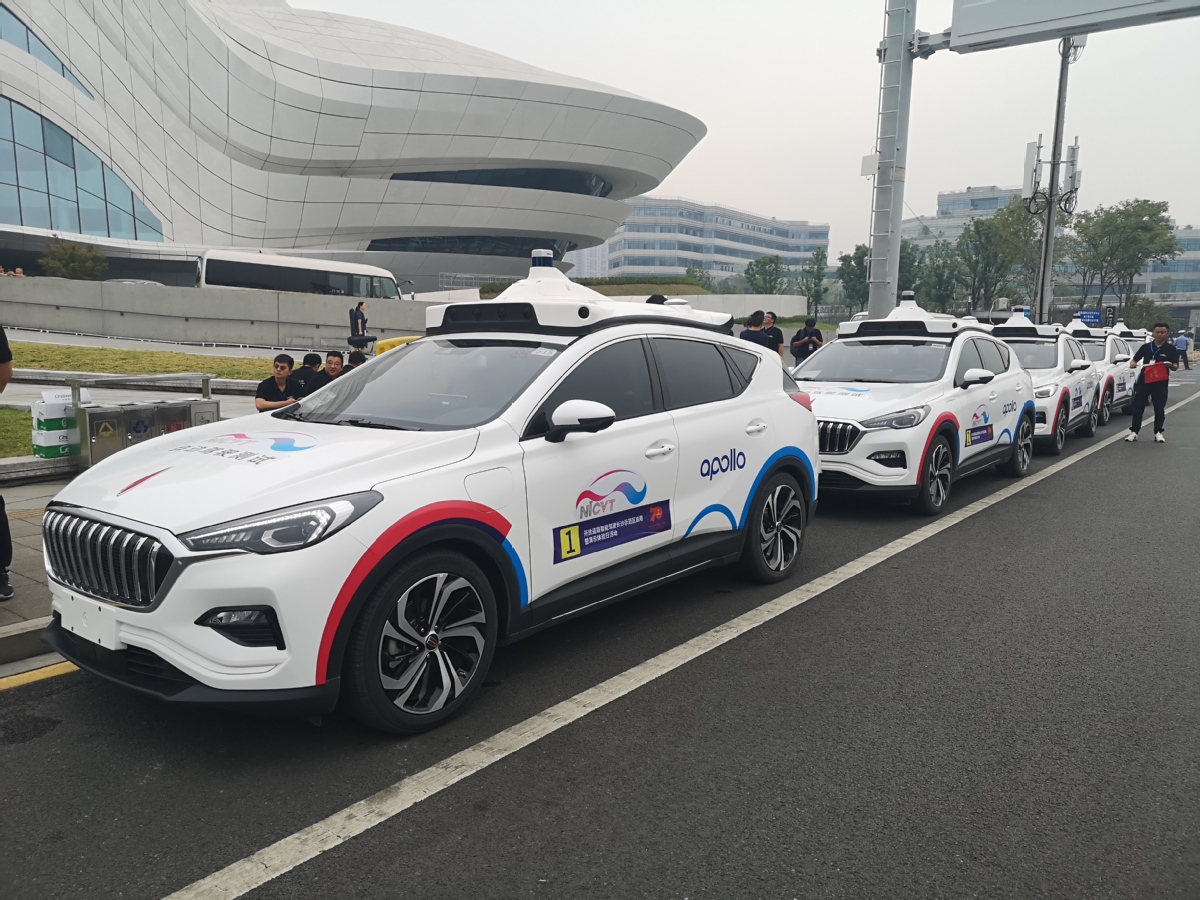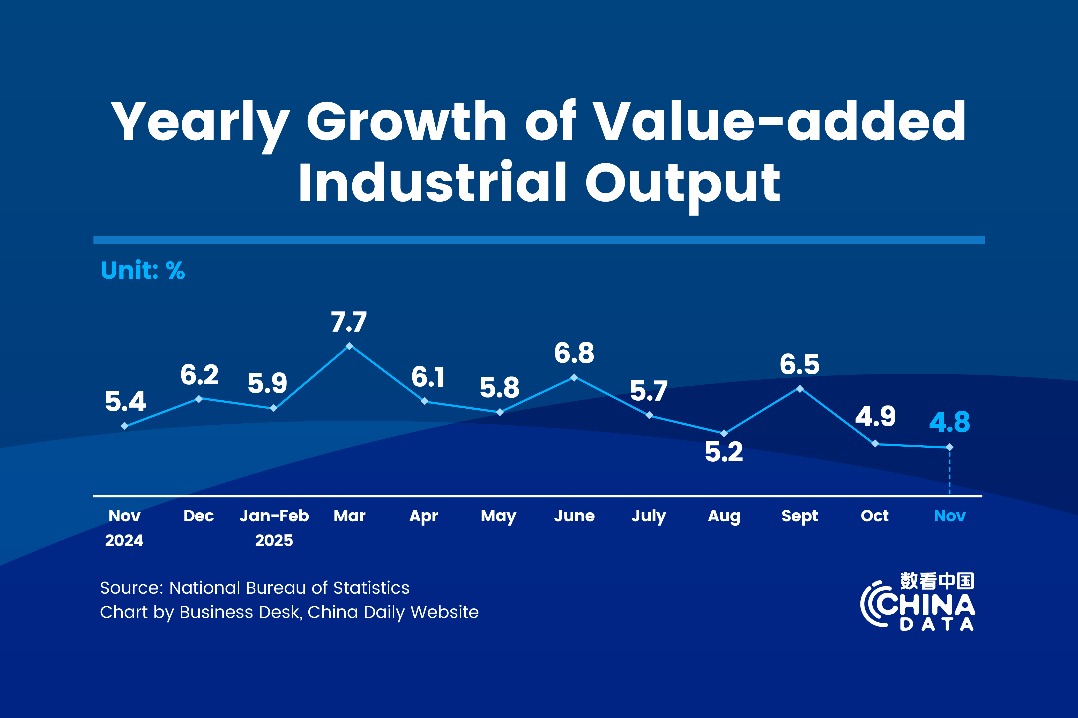Vroom, vroom, automated cars ready to zoom


China on its way to becoming the world's largest market for unmanned vehicles
China is about to redefine 'auto' in automobile.
Chen Zhiqiang, 53, a taxi driver in Guangzhou, Guangdong province, for over 20 years, knows all about it.
He believed driverless or fully automated vehicles were a myth until reality, in the form of an autonomous blue taxi, materialized in front of him recently. Chen was astounded to see a white sensor box on its roof, which guided the blue vehicle to stop bang in front of him.
Upon entering the taxi, an automated female voice guided Chen to the iPad in the backseat and instructed him to key in his destination. Once he settled and fastened his seat belt, the taxi started moving automatically and wound its way steadily, without any human intervention.
"I just couldn't move my eyes off the steering wheel, which kept turning left and right by itself. I can't believe that a cold, lifeless machine will replace us human drivers and is capable of negotiating even complicated road conditions," he said.
Chen recalled that during the 25-minute ride, the taxi, in a clinical fashion, made short work of complex scenarios such as crossing lanes, entering and exiting ramps, changing lanes, and overtaking trucks.
Chen was among the many citizens in Guangzhou who were surprised by the precision of automated vehicles during the launch of self-driving taxis, or robotaxis, in late June, after the country's autonomous driving startup WeRide announced that its self-driving taxi service will be available on Alibaba's navigation platform Amap.
On Sept 10, internet search giant Baidu Inc launched Apollo Go Robotaxi, its self-driving taxi service, in Beijing. It became the first company to carry passengers in autonomous vehicles in the capital.
With nearly 100 pickup and drop-off stations covering residential and business areas in Haidian, Yizhuang and Shunyi, the service encompasses the largest total area and longest road network of about 700 kilometers for manned autonomous driving test area in China.
But WeRide was the first autonomous vehicle company to start driverless vehicle fleet test in China. It represents a group of Chinese startups that revved up autonomous driving commercialization recently to catch up with Silicon Valley, especially after the COVID-19 outbreak sped up driverless applications.
"While players such as Waymo are halting their robotaxi pilots during the pandemic, over 30 companies are deploying autonomous delivery solutions in China," said Bill Russo, founder of Shanghai-based consultancy Automobility.
Russo said in a note that the pandemic has also led stakeholders to comprehend the innate benefits of autonomous and robotics technologies, which were previously understood only from a productivity standpoint.
"A more dynamic system built upon autonomous and robotics technologies will allow economies and businesses to adapt to the rapidly transforming world and the new challenges it brings, such as more flexible and less centralized manufacturing," he said.
In June, ride-hailing market leader Didi Chuxing opened its on-demand robotaxi services in Shanghai. It followed tech giant Baidu Inc, known for its Apollo self-driving platform, which in April announced the opening of its self-driving taxi service in Changsha, Hunan province.
Momenta, a Daimler-backed Chinese autonomous driving startup, said that some of its vehicles will be driverless by 2022 in Suzhou, Jiangsu province, where it received a test license, and its entire robotaxi fleet will operate without backup drivers from 2024.
The sector has also witnessed a flurry of major deals in the past few months. For instance, the autonomous driving unit of Didi Chuxing received $300 million in investment from Japan's SoftBank. Pony.ai, a self-driving vehicle startup based in both China and the United States, finished a new round of funding totaling $462 million.
According to the latest report from global management consulting firm McKinsey & Co, China will become the world's largest market for autonomous vehicles, with revenue from sales of such new cars and mobility services expected to exceed $500 billion by 2030.
It predicted that by 2030, the total sales value of autonomous vehicles is expected to hit $230 billion and autonomous vehicle-based services will generate a gross booking of around $260 billion.
Wu Gansha, CEO of Chinese self-driving startup Uisee, believes the sector is now ready for a takeoff. "Investors are more confident about the commercialization of intelligent driving and hence willing to invest. From this year, we should start seeing large-scale commercialization of driverless vehicles," Wu said. "We've been seeing a healthy pickup in orders."
His startup focuses on high-level autonomous driving and completed a new round of financing in February. On Aug 28, Uisee signed a strategic cooperation with China Automotive Innovation Corp. The two companies will carry out in-depth cooperation in leading intelligent driving car technologies, products and services for a new intelligent travel ecosystem.
Currently, the nation's robotaxis are based on Level 4 autonomous driving, where a vehicle can run autonomously without human intervention in most cases. Autonomous driving is divided into six levels, 0 to 5.
Level 3 refers to "eyes off" in which the vehicle will handle situations requiring an immediate response, but the driver must still be prepared to intervene within a limited time. Level 5 is the highest standard, which means no human intervention is required at all.
For the time being, the country's robotaxis are all equipped with abackup driver in the car to ensure safety in case of emergencies. Companies also rely on safety control centers to monitor self-driving vehicles and road conditions in real time and give timely assistance and instructions to vehicles in need.
"Robotaxi can generate huge economic benefits in terms of profitability of labor cost savings. Replacing drivers with driverless technology will save 60 percent of total costs," said Yang Zeyuan, an analyst from CITIC Securities.
For most robotaxi services, passengers pay the same fares as that of regular taxis. In Guangzhou, for instance, passengers pay a flagfall of 12 yuan ($1.7) and another 2.6 yuan every kilometer.
"The advanced technology requires many inputs, which may lead to difficulties in the short-term profitability of operating robotaxis. But we are bullish on long-term profit prospects," Yang said.
"With people's increasing demand for ride-hailing services, robotaxis will usher in broader development prospects in the country. It is also expected that the global market will reach hundreds of billion dollars in the near future," Yang said.
Earlier this year, China unveiled a blueprint to boost autonomous driving in the country. The country will realize "scale production of vehicles capable of conditional autonomous driving and commercialization of high-level autonomous vehicles in certain scenarios by 2025".
The document further stated: "Smart vehicles have become a global strategy and China has a strategic edge in developing smart cars with the complete automobile industry and evolving information technology."
In March, the Ministry of Industry and Information Technology launched classification standards for autonomous driving in China, which has helped expedite the country's autonomous driving industry.
However, Mo Luyi, general manager of the Guangzhou branch of Pony.ai, holds a relatively cautious view on the commercialization and development of the autonomous travel sector in the country.
"The entire technology of autonomous driving is still in an early stage of rapid development. It is still relatively early to talk about competition. Now the entire industry is constantly working hard and breaking through some technical difficulties in order to solve major problems."
Unmanned and scale development are two premises to achieve the commercialization of autonomous driving. Only after these two goals are reached, the entire autonomous driving technology can truly have very high profit application scenarios, she said.
"To clarify, unmanned means that the technology has to advance to a point where the driver can be safely removed from the driving position to achieve a safe driving status. The scale development is not simply a few cars running in one or two cities, but from several to dozens to hundreds, even thousands, of cities."




































